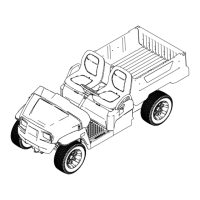3. On a level surface, roll the machine straight back
2 to 3 m (6 to 10 ft) and then straight forward
to the original starting position. This allows the
suspension to settle into the operating position.
Adjusting the Camber
Owner provided tools: spanner wrench, T oro Part
132-5069; refer to your authorized T oro distributor .
Important: Make the camber adjustments only
if you are using a front attachment or if there is
uneven tire wear .
Note: This procedure can be performed on the front
and rear tires.
1. Check the camber alignment at each wheel; the
alignment should be as close to neutral (zero)
as possible.
Note: The tires should be aligned with the tread
evenly on the ground to reduce uneven wear .
2. If the wheel camber is out of alignment, use the
spanner wrench to rotate the collar on the shock
absorber to align the wheel ( Figure 51 ).
g41 1802
Figure 51
1. Shock-absorber spring 3. Spring length
2. Collar
Adjusting the Front Wheel T oe-in
Important: Before adjusting toe-in, ensure that
the camber adjustment is as close to neutral as
possible; refer to Adjusting the Camber ( page 43 ) .
1. Measure the distance between both of the front
tires at the axle height at both the front and rear
of the front tires ( Figure 52 ).
g009235
Figure 52
1. T ire center line—back 3. Axle center line
2. T ire center line—front
2. If the measurement does not fall within 0 to +/-
3 mm (0 to +/- 1/8 inch), loosen the jam nuts at
the outer end of the tie rods ( Figure 53 ).
g033219
Figure 53
1. T ie rod 2. Jam nut
3. Rotate both tie rods to move the front of the tire
inward or outward.
4. T ighten the tie rod jam nuts when the adjustment
is correct.
5. Ensure that there is full travel of the steering
wheel in both directions.
43

